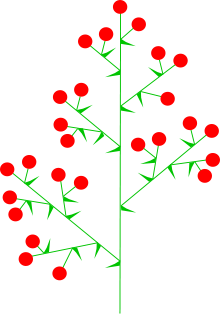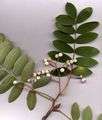Panicle
A panicle is a much-branched inflorescence.[1] Some authors distinguish it from a compound spike inflorescence, by requiring that the flowers (and fruit) be pedicellate (having a single stem per flower). The branches of a panicle are often racemes. A panicle may have determinate or indeterminate growth.

This type of inflorescence is largely characteristic of grasses such as oat and crabgrass,[lower-alpha 1] as well as other plants such as pistachio and mamoncillo. Botanists use the term paniculate in two ways: "having a true panicle inflorescence"[lower-alpha 2] as well as "having an inflorescence with the form but not necessarily the structure of a panicle".
Corymb
A corymb may have a paniculate branching structure, with the lower flowers having longer pedicels than the upper, thus giving a flattish top superficially resembling an umbel. Many species in the subfamily Amygdaloideae, such as hawthorns and rowans, produce their flowers in corymbs.
Latin names
Paniculatus (masculine), paniculata (feminine) and paniculatum (neuter) are genders of a Latin adjective meaning “paniculate”. These terms are often used in the specific epithets of binomial names (mostly plants), indicating that the flowers are borne in panicles. By far the most common gender is the feminine paniculata, because most Latin plant names are feminine. The term is occasionally used for other organisms.
- Allium paniculatum, pale garlic
- Andrographis paniculata, creat or green chireta
- Buddleja paniculata
- Caldcluvia paniculata, tiaca
- Canna paniculata
- Celastrus paniculatus, black oil plant
- Celtis paniculata
- Clematis paniculata, puawhananga
- Crocosmia paniculata
- Cussonia paniculata, kiepersol
- Ericameria paniculata, Mojave rabbitbrush
- Eucalyptus paniculata, grey ironbark
- Goodenia paniculata, branched goodenia
- Gypsophila paniculata, baby’s breath
- Hydrangea paniculata, panicled hydrangea
- Julbernardia paniculata, muchesa
- Koelreuteria paniculata, pride of India
- Mertensia paniculata, tall lungwort
- Murraya paniculata, orange jessamine
- Neslia paniculata, ball mustard
- Olea paniculata, native olive
- Phlox paniculata, garden phlox
- Quoya paniculata
- Saxifraga paniculata, alpine saxifrage
- Solanum paniculatum, jurubeba
- Symplocos paniculata, Asiatic sweetleaf
- Syzygium paniculatum, magenta lilly pilly
- Talinum paniculatum, fameflower
- Toxicoscordion paniculatum, foothill deathcamas
- Uniola paniculata, sea oats
 White-fruited rowan (Sorbus glabrescens) corymb: the branched structures holding the fruit
White-fruited rowan (Sorbus glabrescens) corymb: the branched structures holding the fruit_red_flowers_(46724994502).jpg) Crocosmia paniculata
Crocosmia paniculata Gypsophila paniculata
Gypsophila paniculata- Koelreuteria paniculata
See also
- Thyrse, a branched inflorescence where the main axis has indeterminate growth, and the branches have determinate growth
Notes
- Technically, the inflorescence unit in a grass is the spikelet, but the arrangement of spikelets may be described as a panicle.
- "In the form of a panicle"[1]
References
- Hickey, M.; King, C. (2001). The Cambridge Illustrated Glossary of Botanical Terms. Cambridge University Press. p. 30. ISBN 978-0521790802.
A much-branched inflorescence.
(softcover ISBN 978-0521794015).